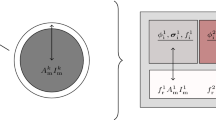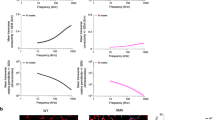Abstract
Recent experiments carried out in our laboratory with the four-electrode method showed that the electrical conductivity of skeletal muscle tissue depends on the frequency of the injected current and the distance between the current electrodes. A model is proposed in order to study these effects. The model takes into account the structure of the tissue on the scale of individual fibres. It discerns three main components with respect to electrical properties: (a) extracellular medium with electrical conductivity σe; (b) intracellular medium with electrical conductivity σi; (c) muscle fibre membrane with impedance Zm. The model results show an apparent frequency dependence of the electrical conductivity of skeletal muscle tissue, as well as the way the conductivity is affected by the length the current is conducted.
Similar content being viewed by others
References
Burger, H. C. andvan Dongen, R. (1960) Specific electric resistance of body tissues.Physics in medicine and biology,5, 431–447.
Epstein, B. R. andFoster, K. R. (1983) Anisotropy in the dielectric properties of skeletal muscle.Med. & Biol. Eng. & Comput.,21, 51–55.
Gielen, F. L. H., Wallinga-de Jonge, W. andBoon, K. L. (1984) The electrical conductivity of skeletal muscle tissue: experimental results from different muscles in vivo.Med. & Biol. Eng. & Comput.,22, 569–577.
Haas, H. G. andBrommundt, G. (1980) Influence of intercellular clefts on potential and current distribution in a multi fiber preparation.Biophys. J.,30, 327–350.
Maxwell, J. C. (1896)A treatise on electricity and magnetism, 3rd edn. Dover, New York.
Nicholson, P. W. (1965) Specific impedance of cerebral white matter.Experimental neurology,13, 386–401.
Oosterom, A., van de Boer, R. W. andvan Dam, R. Th. (1979) Intramural resistivity of cardiac tissue.Med. & Biol. Eng. & Comput.,17, 337–343.
Plonsey, R. andBarr, R. (1982) The four-electrode resistivity technique as applied to cardiac muscle.IEEE Trans.,BME-29/7, 541–546.
Rush, S., Abildskov, J. A. andMcFee, R. (1963) Resistivity of body tissues at low frequencies.Circulation research,12, 40–50.
Author information
Authors and Affiliations
Rights and permissions
About this article
Cite this article
Gielen, F.L.H., Cruts, H.E.P., Albers, B.A. et al. Model of electrical conductivity of skeletal muscle based on tissue structure. Med. Biol. Eng. Comput. 24, 34–40 (1986). https://doi.org/10.1007/BF02441603
Received:
Accepted:
Issue Date:
DOI: https://doi.org/10.1007/BF02441603




